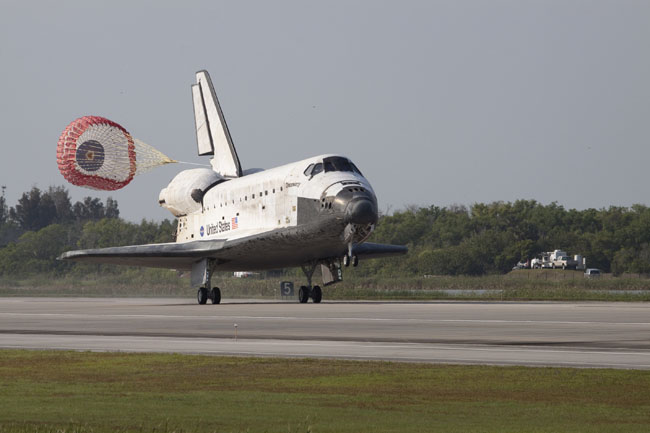What Will NASA Do With the Retired Space Shuttles?

Spaceshuttle Discovery, one of three remaining orbiters in NASA's space shuttlefleet, landed Tuesday morning at Kennedy Space Center in Florida after a 15-daymission to the International Space Station.
Themission was the penultimatemission for the aging Discovery, and one of the final four planned space shuttleflights before NASA retires all three shuttles at the end of September.Discovery's final mission is currently scheduled September, and will mark thefinal flight of the space agency's space shuttle program.
Butretirement for the space shuttles simply means the start of their lives in thepublic eye. All three orbiters ? Discovery, Atlantis and Endeavour ? areexpected to be placed on public display at one of more than 20 museumscurrently vying for one of the iconic 76-ton shuttles. NASA's two othershuttles, Challenger and Columbia, were tragically lost in accidents in 1986and 2003, respectively. In all, 14 astronauts were killed in the two accidents.
Discovery,the oldest of NASA's shuttles, has already been promised to the Smithsonian Airand Space Museum in Washington, D.C., leaving Atlantis and Endeavour availablefor other institutions. Discovery will replace the testshuttle Enterprise, which has been on exhibit in the Smithsonian's StephenF. Udvar-Hazy Center, in Chantilly, Va., since 2003. So Enterprise, which wasbuilt between 1974 and 1976 and was used for NASA's Approach and Landing Testprogram, will also be looking for a new home.
Someof the institutions trying to snag one of the other retired orbiters include:the Johnson Space Center in Houston; the National Museum of the U.S. Air Forceat Wright-Patterson Air Force Base in Dayton, Ohio; the Museum of Flight inSeattle; and the Intrepid Air & Space Museum in New York City.
"Therivalry may be unprecedented in space artifact history. In the past, theSmithsonian took ownership of all spacecraft and then loaned them to otherinstitutions," explained Robert Pearlman, editor of collectSPACE.com, an onlinepublication and community for space history and artifact enthusiasts, and a SPACE.comcontributor.
"With the two shuttles (and perhaps even with the unflownprototype Enterprise), NASA will decide who gets a shuttle... for keeps. Add tothat the limited availability as compared to Apollo for example, when therewere many more capsules to go around, and you have the makings of a space raceamong museums where the prize is no less than the world's first and most famousreusable space plane," he added.
Breaking space news, the latest updates on rocket launches, skywatching events and more!
Earlierthis year, NASAreduced the price of its museum-bound space shuttles from $42 million, setin December 2008, to $28.2 million. Chosen museums will, however, have to payfor ferrying the orbiters atop NASA's modified Boeing 747 aircraft from KennedySpace Center in Florida to their destination.
"Understandably,with only two of the three remaining flown orbiters available to museums ? thethird rightfully headed to the Smithsonian ? the competition risen to match therarity of the 'prize,'" Pearlman said.
"Museums have staged publicevents, collected thousands of signatures on petitions, sought endorsements,filmed commercials, and have even traveled to Washington to lobby theirpolitical representatives. Some museums have even begun the construction ofdisplay enclosures, pledging millions of dollars, without even knowing if theywill receive a space shuttle."
Theearliest that NASA is expected to announce the final homes for Atlantis,Endeavour and Enterprise is July 2010, which would give the selected museumsapproximately one year to raise funds and build the required indoor housing forthe shuttles.
Animportant part of Discovery's exhibit at the Smithsonian will be thepreservation of the historic shuttle, said Roger Launius, a senior curator atthe Smithsonian National Air and Space Museum.
?It'sa big honor for a museum to get one of these objects to put on display,"Launius told Life'sLittle Mysteries, a sister publication of SPACE.com. "At theSmithsonian, we want to take Discovery and freeze it in time so that fivehundred ? even a thousand ? years from now, there will be this orbiter that ispristine from when it last flew.?
- Images ? Shuttle Discovery's Mission in Pictures
- Morning Star: The Pre-dawn Launch of Shuttle Discovery
- The Best Manned Spaceships of All Time

Denise Chow is a former Space.com staff writer who then worked as assistant managing editor at Live Science before moving to NBC News as a science reporter, where she focuses on general science and climate change. She spent two years with Space.com, writing about rocket launches and covering NASA's final three space shuttle missions, before joining the Live Science team in 2013. A Canadian transplant, Denise has a bachelor's degree from the University of Toronto, and a master's degree in journalism from New York University. At NBC News, Denise covers general science and climate change.
